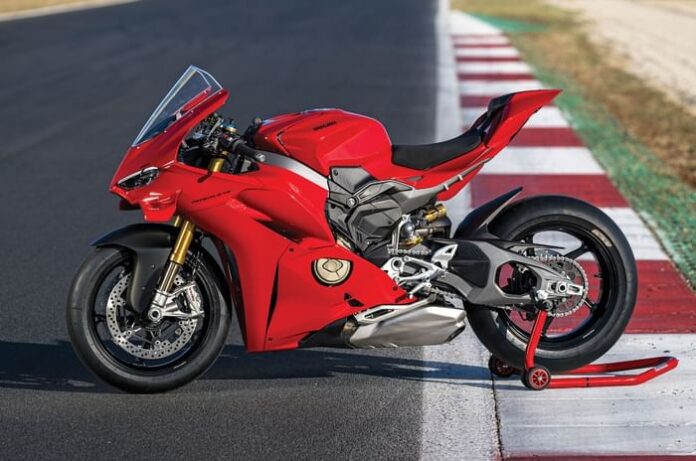The Panigale V4 takes a big leap forward in user-friendliness, and that it has gotten even faster in the process.
I have always had a bit of a tortured love affair with the Ducati Panigale V4. It is, in my mind, the most exotic and violently exciting motorcycle of its kind. However, every ride on one over the years has left me feeling simultaneously blown away but also disappointed in myself. Unlike some rivals that instantly make you feel like a riding hero – particularly the one from Germany – the Panigale always left a lingering feeling that I just wasn’t good enough for it.
The best way I can explain it is that it felt like the bike’s chassis and suspension were designed to excel when loaded with tremendous speed and brake force going into a corner – the kind of commitment a rider with my skill level simply could not provide. Ducati has obviously been aware of this because every update since the V4 debuted in 2018 has been centred around the phrase “easier to ride”. While it certainly did evolve in that general direction, the Panigale has never quite nailed that description – until now.
Ducati Panigale V4 S performance – 10/10
One of the hardest accelerating motorcycles on the market
The changes this time around are so vast that Ducati is calling this a new-generation bike – its 7th-gen superbike, to be precise. The engine is the same 1,103cc V4, but it’s massaged to produce even more power (up slightly to 216hp) while somehow also adhering to even stricter Euro 5+ emissions norms, which is just incredible. Torque has dropped slightly, but the only real loss is that the engine is now a little quieter than before – again, thanks to stricter norms.
| Engine | |
|---|---|
| Ducati Panigale V4 S | |
| Engine | V4, 1103cc, liquid-cooled |
| Power | 216hp at 13,500rpm |
| Torque | 121Nm at 11,250rpm |
The bigger changes are at a chassis level, with the aluminium frame modified to offer a huge 40 percent reduction in lateral stiffness while also shedding 700gm. The controversial new double-sided swingarm also brings in weight savings as well as a 37 percent reduction in lateral stiffness. There are new forged wheels and the latest Brembo Hypure front calipers, which are slightly lighter than the previous Stylemas and claim even better heat dissipation for more consistent performance. And the final major chassis update is the move to Öhlins’ latest ECE 3.0 semi-active suspension (on the S model) that promises a wider operating range of damping capabilities at both the firm and soft ends of the spectrum.
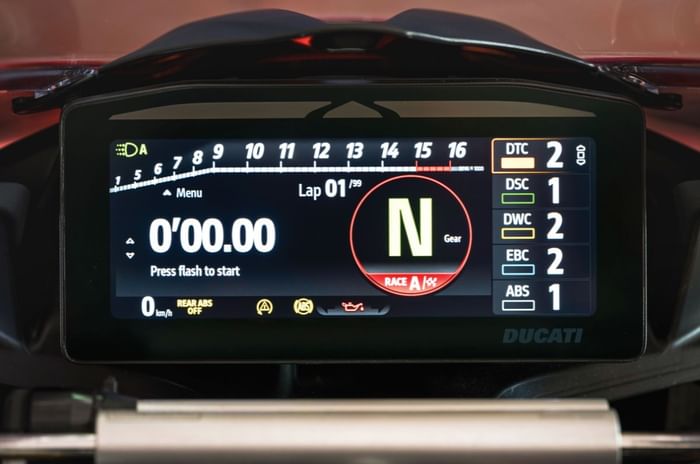
Large TFT is easy to read and packed with valuable information.
Another significant improvement for me is that the riding position is now designed to be more roomy with a reprofiled fuel tank that is now easier to grip. Ducati also continues to lead the charge in the MotoGP-derived electronics game, with a new horizontally laid-out TFT being the poster child for a deep rabbit hole of electronic customisation options. The one feature that stands out this time around is the new eCBS, which essentially introduces some rear brake inputs while entering a corner (to tighten the line) and even on exit (to help with anti-wheelie). This is something the pro riders manually do, but most amateurs struggle to find the spare brain capacity to manage rear brake inputs at racetrack speeds.
Ducati Panigale V4 S handling – 10/10
Easier and more encouraging, but also more capable
So, how does all this translate to the race track? Ducati invited us to one of its DRE (Ducati Riding Experience) events at the Chang International Circuit in Thailand to find out, and the result was three of the most memorable, euphoric track riding sessions I’ve had in a long, long time.
The first session was all about recalibrating my brain to the outlandish speed. Previous experience at this track reminds me that it has two fairly long straights, but on the V4, it’s almost like they don’t exist at all. It takes just seconds before the little speedometer on the bottom left of the Race layout on the TFT display flicks past 290kph, and it keeps climbing at a remarkable rate before I bail out and haul on the brakes.
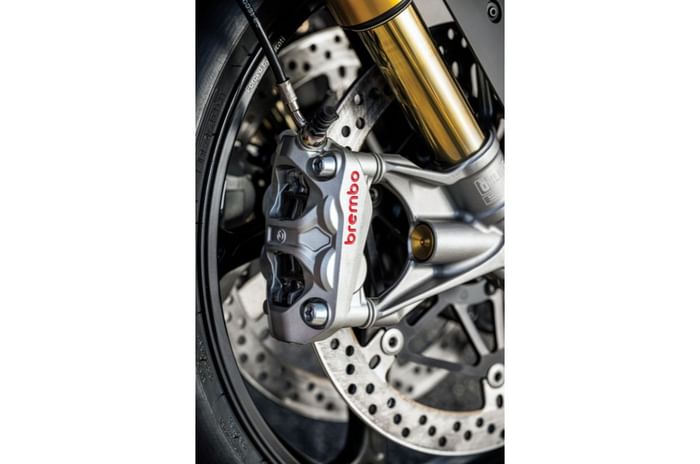
The new BremboHypure brakes have incredible feel and power
Panigales have always been the forerunners of the latest Brembo brakes, and these new Hypurecalipers build on the already exceptional Stylema’s feel and performance. No matter how brave I was about my braking markers, it felt like the brakes could take much more abuse. As we gently rolled back into the pits at the end of the session, the plumes of hot air gently cooking my left thigh were an amusing reminder that with great Ducati power comes great Ducati heat. Then again, the company says it has further improved the V4’s cooling system, which was always quite effective at handling race track speeds – even in our weather.
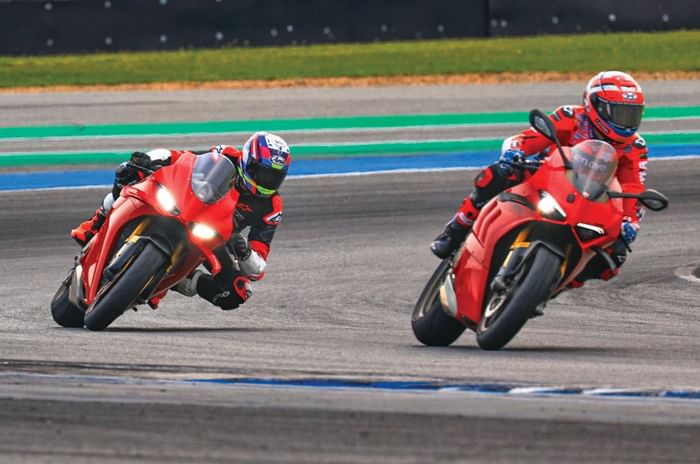
That’s me attempting to follow Ducati’s official MotoGP test rider, Michele Pirro, who is riding at a very sedate pace by his standards. It’s also a nice comparison of how the new Panigale looks next to the previous-gen bike.
With a little familiarity in the bag, session two was less of a brutal assault on the senses, which allowed me to observe other things. First, the revised riding ergonomics had me feeling less awkward (and, thereby, less exhausted), and I could tell that the bike felt lighter and more agile than before. Then, there was the way the Panigale dipped into corners with less effort than I recalled and also laid down the power on exits without any of the bucking and weaving that the previous-gen models tended to do. However, by this point, it felt like the suspension was a little too soft for the speeds we were now carrying, and I was keen to switch from Sport mode to Race mode in the next session.
| Key specs | |
|---|---|
| Ducati Panigale V4 S | |
| Kerb weight | 198kg |
| Wheelbase | 1485mm |
| Fuel tank | 17-litre |
| Seat height | 850mm |
| Suspension (F/R) | USD fork/monoshock |
| Brakes (F/R) | Twin 330mm discs/245mm disc |
| Tyres (F/R) | 120/70-ZR17 / 200/60-ZR17 |
There are two Race modes, each of which can be individually tuned to your liking via a dizzying array of engine, suspension, and electronic settings. The only setting I changed within Race Mode B was lowering the ABS to Level 1, which supposedly provides the full e-CBS effect and deactivates the ABS at the rear. Engine response is noticeably ramped up in the Race modes, but amazingly, it’s still not the full, unrestricted violence in the first few gears, and you’ll need to individually set that in the settings menu. That was something I had absolutely no desire to do, given how easily the bike was already lifting its front wheel on slow corner exits.
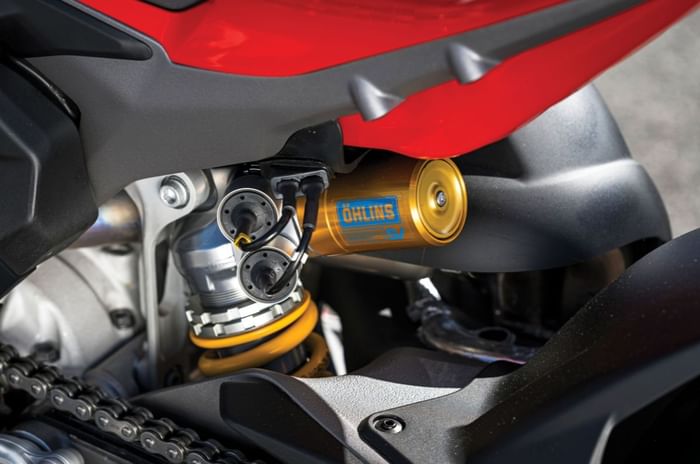
The V4 S gets the latest Öhlins electronic suspension
The most delectable change, however, was how taut and accurate the firmer suspension damping in Race mode made the bike feel. The Panigale now turned in and held a tight line in a way I have never experienced on a fast Ducati, and it somehow still found superb traction on a rather worn set of Pirelli Supercorsa SP tyres. I wonder how much of that tight turn-in was due to the firmer suspension and how much was from the clever rear brake system. Whatever that ratio was, it was, it worked beautifully, and those few laps trying to keep pace with Ducati’s official MotoGP test rider, Michele Pirro, directly ahead of me were some of the most exhilarating I’ve ever had – even though it was plainly obvious that he was riding at what was an embarrassingly casual pace by his standards.
Ducati Panigale V4 S verdict – 9/10
More desirable and rewarding than ever, but at a massive price
Sadly, three sessions are all we got, and it would take more like three days to truly unravel how much this bike has to offer. However, the one clear takeaway I have is that it is now vastly more enjoyable for a much wider audience of non-superhero riders- and that has me filled with newfound and unconditional love for the Panigale V4.
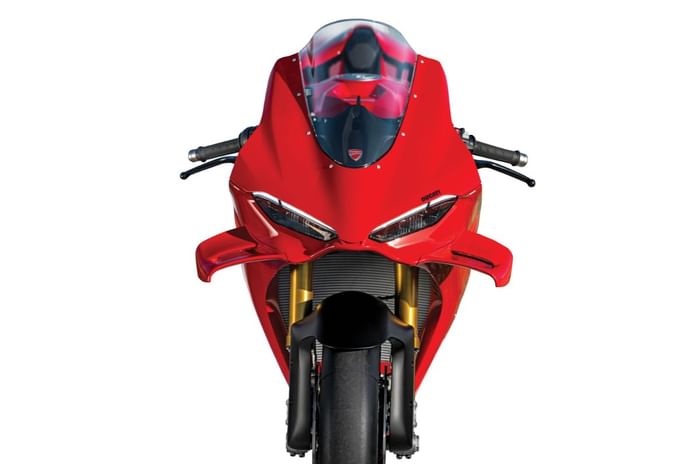
That being said, there is the caveat that, while it may be easier than before, this is still an overwhelmingly rapid motorcycle that demands respect and a decent amount of skill and experience. There’s also the fact that a bike this explosive needs a big and flowing GP-level track to be truly enjoyed – I suspect it will continue to feel like a caged (and enraged) wild animal if you take it to some of our smaller southern circuits. And, of course, there’s the exorbitant Rs 36.50 lakh ex-showroom price, which means you’ll need a lot more than a heart filled with sunshine and rainbows to be able to afford one. But my god, if you can, you should!
Also see: Suzuki GSX8R review: the subtle sportsbike
